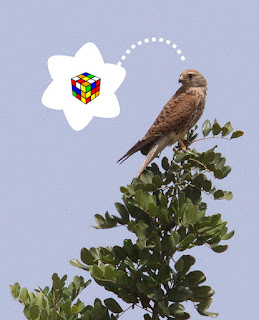You may cheat the challenge from Rubik's cube by solving it through just seven auto-pilot steps, but taking the painstaking intellectual path without guidance is potentially million of times harder! However, in fact you will then (perhaps unintentionally) stretch your mental capacity and drastically improving your odds by invoking parallel processing. In this post I argue that this "trick" is very similar to the basic principles I'm touting by advocating Multi-scaled Random Walk (MRW), underlying the animal space use model.
 |
| Deep thinking by kestrel. Photo: AOG. |
Theoretically, there are 43,252,003,274,489,856,000 (43 quintillion) possible combinations of Rubik moves if you do it by random steps. Mathematically, this approach satisfies a first-order Markovian process. In other words, the future is independent of the past, given the present. As I have repeatedly stated in my book, papers and in this blog, the standard theory of animal space use (both at the individual and population level) rests on this principle.
However, an individual that invokes parallel processing will combine tactics and strategy when considering what to do next; e.g., where to move in the next step.
Following the Rubik's cube analogy, you may often have to re-scramble some moves at the side of the cube that you have almost finished, in order to gain further progress. Some steps backwards may lead to better success going forward. Mentally, you are then not only combining tactics and strategy in the same instant of time, but also invoking both temporal and spatial memory to achieve future progress. Spatial mapping regards recalling the state of currently invisible sides of the cube, in order to purposely switch colour positions of the small squares on the side(s) in current view.
In the complex world that animals are coping with, parallel processing makes the statistical difference between survival and death. Thus, a Markovian kind of behaviour should not represent the cornerstone on modelling animal movement; neither mathematically nor statistical-mechanically*. Out goes all standard models both in the field of individual movement and population dynamics. In comes a fresh approach, of which parallel processing of MRW and the Zoomer model may be worth exploring (Gautestad 2021, 2022).
NOTE
Some individual-level models have been proposed, where the animal is maintaining a running window of spatio-temporal memory of the latest set of n visited positions and their respective attributes; in other words, an n-order Markovian process. However, coarse-graining the path by sampling every n'th step or beyond re-introduces the characteristics of an ordinary Markov system.
REFERENCES
Gautestad, A. O. 2021. Animal Space Use, Second Edition: Memory Effects, Scaling Complexity and Biophysical Model Coherence. Cambridge Scholars Publishing, Newcastle upon Tyne.
Gautestad, A. O. 2022. Individual Network Topology of Patch Selection Under Influence of Drifting Site Fidelity. Frontiers in Ecology and Evolution 10:695854.
